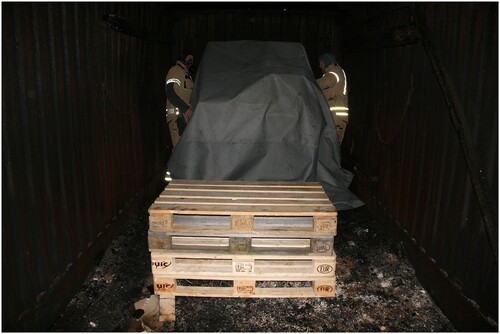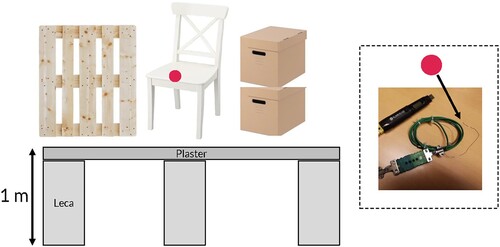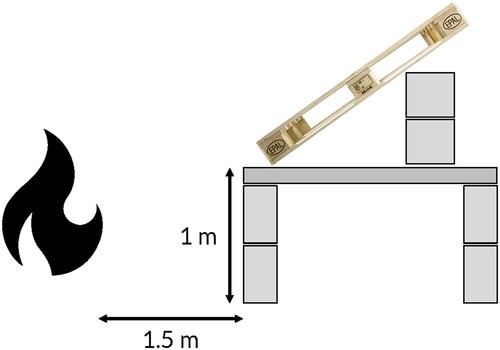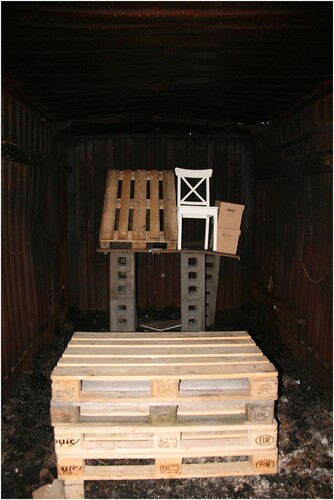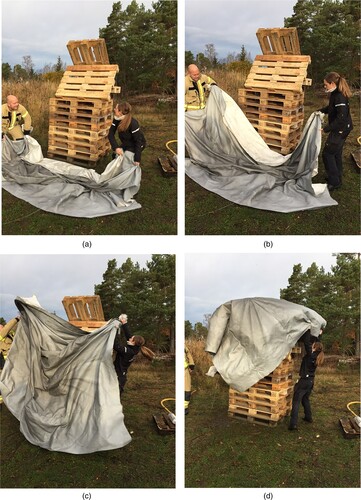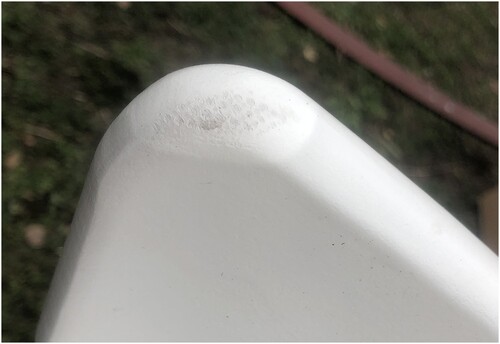ABSTRACT
Since the 1990s, the Norwegian management for cultural heritage has increased its focus on finding effective solutions for protecting Norway’s wooden cultural heritage from fire damage. The medieval churches in general, including the wooden stave churches, with their interiors and inventories, are of special interest. However, the usefulness of protecting valuable interiors and inventories when fighting fire has been questioned. An experiment was carried out to find manageable solutions for protecting large inventories by using fire covers in case of fire. An experiment using seven commercially available products was conducted by fire fighters to investigate whether these products could protect historic interiors from water and fire. The preliminary results show that it is possible to find manageable, large format covers for the protection of large, immovable historic inventories.
Introduction
A survey of the use of fire covers in Norway, Sweden, Denmark, England, and Scotland shows that very few managers and owners use fire-protective textiles as part of preventive routines in their historic buildings or for use in a salvage situation. However, managers and owners of historic houses and museums recognise the value of having fire-protective textiles to minimise damage from fire and water. Due to the lack of relevant information on the use of such textiles for reducing damage to historic interiors, there is a need for increased knowledge of their manageability, use, and protective abilities (Kjølsen Jernæs Citation2020).
The textile covers can have different designs, depending on the desired protection and the type of object or the part of the interior. They can be large covers, tailored covers, curtains, or other types of textiles that are used to protect materials against heat and soot damage and to prevent the fire from spreading. The focus of this study was on fire covers (also commonly referred to as fire-protective textiles/ covers/ blankets and fire-retardant fabrics) that are used in situations where it is desirable to protect cultural-historical objects, parts of interiors, fixed pieces of furniture, murals and so on, from fire spread and damage from fire, heat, soot, and water.
A previous literature review on the use of fire-protective covers for cultural heritage items mentions relevant research studies and project reports (Kjølsen Jernæs Citation2020). The use of fire-protective covers is only mentioned in project reports that deal with emergency preparedness for historic buildings in general, without being the focus of the report (Fällman and Hansing Citation1997, 102; Guideline No. 30 Citation2013, 21; Historic England Citation2017, 28; Nilsen Citation2016, 26; STORM Citation2017, 80). It seems that little research in this area and few tests have been carried out, and this is supported by Takahashi (Citation2019, 3):
The literature on fire blankets is scarce probably because the basic research has not been fully conducted and the R&D [research and development] efforts have mainly been made sporadically at manufacturers without dissemination of test results other than the specifications of final products.
In the literature that deals with a form of covering to protect large, heavy, or fixed objects from fire in situ, it is not further described how, with what, or by whom this is done. Until now, there have been uncertainties about what advice to give when there is no clear knowledge on how fire covers can be handled or how they react. It is also not clear which products are suitable for this specific use. For example, some fire covers that are used for protecting large trees in wildfires will melt in direct contact with flames; a material change that would be devastating in the case of protecting historic interiors.
Previous studies
There are three relevant previous demonstration studies that are known, one published internationally and two unpublished. These three previous studies are reviewed here.
Studies in Conservation published an article on the topic of fire covers for smaller heritage items (Præstegaard, Thomsen, and Woer Citation2021). The aim of testing the fire covers was to investigate the effects of different types of textiles for fire protection of the museum’s interior and heritage artefacts. The experiments were performed using eight different Danish-produced covers on chairs in a realistic fire with subsequent extinguishing. The covers were shaped and fitted to the chairs before the fire experiments. The results showed it was possible to make a useful cover to protect artefacts from fire damage. A two-layered Aerogel cover, consisting of an E-glass needle mat outer layer and the core of a Pyrogel XTE 5-mm mat, provided the maximum protection for the object. All covers were studied to document both heat damage and water damage on chairs and on small material samples.
The Norwegian Institute for Cultural Heritage Research (NIKU) has received unpublished documentation on two previous demonstration studies of fire-protective textiles. One was performed to simulate a wrapped painting and a wooden pallet with possible damage from embers and radiant heat (Brandskyddslaget Citation2012). The painting was wrapped in a fire-protective cover, whilst the pallet was wrapped in a first layer of plastic covered by a second layer of fire-protective textile. They were placed one metre from a pallet tower. The pallet tower collapsed during the test and struck the wrapped pallet. The painting withstood major damage from embers and radiant heat and suffered only damage of discolouring to its surface and the reverse side of the canvas.
The second unpublished demonstration study included various textiles’ water, heat, and flame resistance (Oxford University Citation2020). The study stated the product type but did not describe its material or thickness. The research team tested different ways to wrap and protect an item, customised in size but made of commercially available fabrics. Out of five fabrics, only one was commercially available as a fire-retardant cover. All of them were tested with direct flames and indirect heat. All tested products were satisfactory for protection against water penetration. However, fitted covers leaked slightly along the seams. Large, non-custom textile fabrics worked best. The covers performed differently due to time of self-extinguishment, fumes, and if the object underneath was affected. The fire-retardant cover provided poor protection from flame and heat when compared to the other covers made for water protection. It is uncertain if these results were followed up to find the reason for differences in protection.
Preliminary tests of 2021 and the paper’s research question
To increase knowledge and experience on the use of fire-protecting covers, experiments were carried out in Norway in the autumn of 2021 (Kjølsen Jernæs Citation2021). Based on the experiments, this paper asks this research question: can fire covers be used for minimising damage to historic interiors in case of fire? Important issues regarding minimising damage involved the investigation of heat-insulating and water-repellent properties, as well as handling properties and material stability.
The potential impact of this study is twofold. Firstly, we provide needed general knowledge and focus on key protection and handling properties of these types of textiles. Secondly, the product-specific preliminary findings of the study may be utilised for conservators and heritage authorities when advising on the holistic approach and the specificity of products to choose.
Testing method
Imagined scenario, the basis for the experiments
The scenario that was used as the foundation for the experiments in this study in 2021 was an imagined situation of a historic building on fire, where it was safe for the fire service to enter and cover prioritised items in the building while their colleagues started extinguishing the fire. The cover needs to be deployed quickly, with no time for hesitation regarding which item to be covered or how to do so. The scenario where a fire-protected textile could minimise damage to objects would be fire spread due to glowing particles or radiant heat from a nearby fire. Additionally, there might be damage caused by the extinguishing water from the manual firefighting or the sprinkler system, as well as soot and gases. The imagined scenario gave the basis for the four parts of the tests: manageability, water test (in case of general use for water protection), fire, and water after heat exposure ().
Table 1. Experimental procedure.
Selection, properties, and preparation of the textiles
It was desirable to include textiles produced worldwide to ensure that the study is relevant globally. The knowledge and contacts of the study’s reference group members, research article, and general searches on the Internet were used to get in contact with manufacturers globally. All contacted manufacturers received an information letter about the study. The ones that positively responded that they had relevant products for the study and would participate received the study’s criteria for the textiles. The specifications were provided to the manufacturers for them to match with their products that they believed best met the study’s specifications.
Evaluation criteria provided to the manufacturers:
The aim is for blankets to cope with a room fire, including extinguishing operations, similar to any fire-rated wall enclosure (e.g. fire resistance rated EI 60 S or EI 30 etc.; F/T 60 smoke tight or F/T 30).
Blankets will be assessed for ‘air lift’, and acceptable types will stay in place by gravity.
Smoke and water tightness: the less penetration of smoke particles and water, the higher the score in blanket assessment.
Mechanical impact: sturdiness to withstand falling objects and handling, reuse, transport, and firefighting drill exercises will score high.
Test standards and rating criteria vary across the world, so no specific standards are required. However, test evidence by acknowledged certification organisations will benefit the final assessment of products.
Manageability:
Preferred sample format for testing: 4 × 4 m or larger.
Ease of handling with respect to weight and stiffness.
Grommets/eyelets to ease fixing and wrapping are clearly preferred although not required.
In total, 11 manufacturers were contacted. Some referred to other manufacturers that could meet the criteria listed above. Others did not have products that met the study’s criteria. A number of them sent the products that they believed met the criteria in the best way possible, in total seven different products from seven manufacturers.
Since these types of fire-protective covers are sold in rolls, their width is limited. Because of this, all the tested textiles needed to be sewn to create the required format; 3 × 4 metres or 4 × 4 metres. This was done by each manufacturer in all seven cases. All information on the product properties listed in was conveyed by the manufacturers to the project group through the corresponding Technical Data Sheet or through personal communication when the Technical Data Sheet was not available (relevant for newly developed products). Due to the textile roll’s width, some of the textile covers could easily be manufactured in a 3 × 4 metres size and would be increasingly expensive when made in a 4 × 4 metres size. Due to the study’s budget limitations, the 3 × 4 metres size was accepted for carrying out the tests.
Table 2. Properties of the tested materials.
Each cover tested was a one-layer cover, except for product no. 1. Product 1 was tested as a one-layer fabric in addition to an extra insulation material. The size only covered one of the three material types of objects. This was included in the study so we could get some experience and thoughts on using multi-layered covers.
Experimental set-up and procedure
Three fire services at three fire station locations in Norway were invited to perform the experiments following a given experimental procedure (). There were several reasons for inviting three fire stations. First, there was a general desire for this topic on minimising damage to cultural heritage to be anchored in more than one fire service. Secondly, manageability could be tested by multiple firefighters. This was important, since the evaluation of manageability is a qualitative assessment based on the subjective experience and understanding of the use of these materials by each firefighter. All three fire stations did Part 1 Manageability. Two of the fire stations conducted all four parts of the test as described in and the results can be seen in the graphs ( and ). The products were tested for water resistance both before and after the fire to register possible changed characteristics due to the heat exposure. Not all fire-protective covers are tested for water resistance by the manufacturers. To test a wet or humid cover for fire insulation properties was considered to have limited impact on the results of the insulation test. Testing water before heat also connects to the mentioned imagined scenario with the need for protection against extinguishing water.
Table 3. Preliminary results, overview.
The experimental set-up is shown in . In the part 3 fire experiment, temperature was measured on the unexposed side of the textile using a 0.5 mm type K thermocouple positioned mid-air on top of the chair, logged every 1 s by a portable EasyLog EL-USB-TC-LCD thermocouple data acquisition unit.
Additional manageability test
Handling is an important part of the intended use of fire protection textiles in historic houses and churches. Therefore, the project group chose to conduct an extra experiment focusing on handling properties. The set-up used was designed to imitate the shape of an altarpiece to be covered in the shortest possible time. The result was a ‘pallet tower’, measuring 265 cm (height) × 132 cm (width) × 120 cm (depth). The shape was made to mimic a historic item with angles and protrusions that would challenge the covering procedure.
Preliminary results
Not all points of the criteria sent out to the manufacturers were tested. When sending out the specifications at the project start, this seemed like a relevant issue. However, during the development of the test procedure, it was stated as outside the scope of the project. The specification of possible reuse was also considered not to be relevant: if a cover is used in a fire, one will most likely buy a new cover for future needs.
Although the instructions were clear and one person observed and monitored all the tests to ensure comparability in the results, there were some variations in the temperature reached during the free-burning part of the fire test. The reasons are probably variations in draft, outdoor temperatures, and humidity of the fuel. There may also be some variations in the time when the temperature was measured on the surface, based on the maximum fire temperature that was reached. The variations were between 224 and 270°C on the fabric surface, measured by IR camera. However, high temperatures on the surface did not always correlate with high measured temperature on the inside, which shows tendencies towards good or poor insulation properties when testing different textiles. An overview of the preliminary test results can be read in . Photographs with example damage observed after the experiments are presented in .
Figure 6. Example of damage after the fire test: soot on painted wooden chair. Minimal covering with gaps on the side allowed soot to get inside.
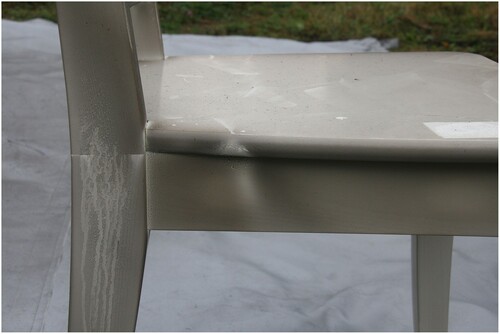
Figure 7. Example of damage after the water test: water damage on painted wooden chair. Minimal covering with gaps on the side allowed humidity to get inside and react, causing the material to swell.
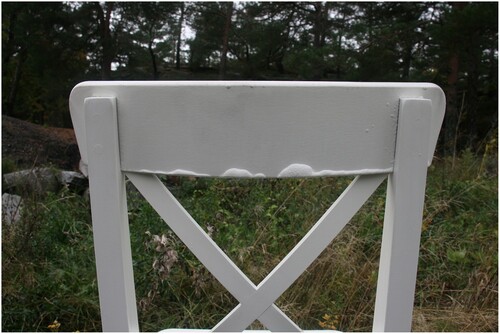
Figure 8. Another example of damages caused by water on the cardboard box. The seams on some of the covers resulted in wet cardboard boxes underneath the cover.
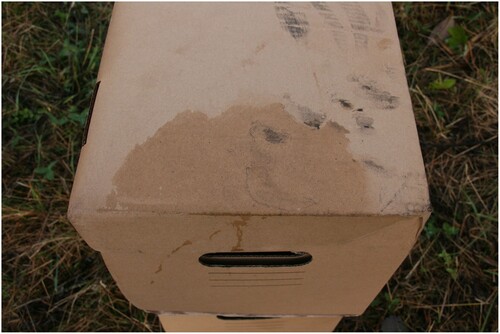
Water protection
For water protection, test products 3, 5, and 6 demonstrated the best results, based on the visual inspection of the damage and water marks on the items.
Handling properties
When testing for handling properties, products 3, 5, and 6 also showed the best results, based on the weight and stiffness/pliability if each product. It was found that a little stiffness in the material, in combination with a light weight, made it easy to cover the different objects quickly. However, if the material was too stiff, it would become difficult to handle.
Insulation properties
The insulation properties were documented by temperature measurements on the unexposed side of the textile. A comparison of the temperature data for all products is presented in . The temperature data for each product is presented in , including the time stamps for events during the test. Key events were ignition, the time when the fire service assessed that the fire had reached its maximum by visual observations of the fire, the logged temperature maximum, time when extinguishing was started, and end of extinguishment. As seen in , in four cases the initial fire development was slow, and fuel was refilled one or two times (indexed by Ignition refill 1 and 2). In one case, the fire re-ignited after termination of the extinguishment, and extinguishment was started again.
Figure 9. Temperature development during the experiments. For product 1a, there is an apparent discrepancy in the temperature measurement compared with its performance (destroyed). This is most likely due to differences in radiant and conductive heat transfer modes (see main text).
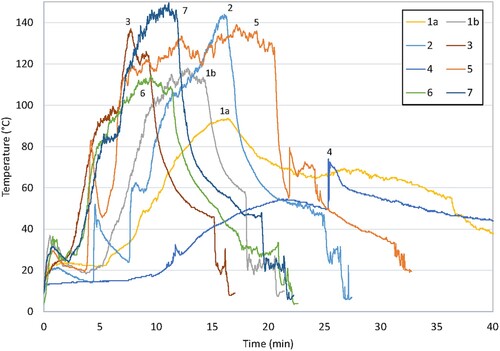
Figure 10. Temperature development during the experiments, with key events during the experiment indicated by vertical lines. Left column are tests performed at fire station 1 (materials 1b, 3, 6, and 7); right column at fire station 2 (materials 1a, 2, 4, and 5). Fire station 3 performed pre-tests, and manageability tests with no temperature recording, and are thus not included in this overview.
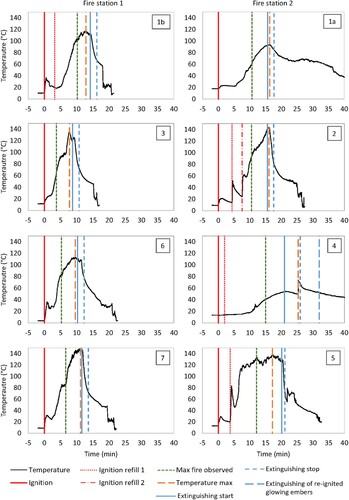
The temperature development and the maximum temperatures measured on the unexposed side give an impression of the insulation capability of each product. Based on an evaluation of the initial temperature development, the amount of fuel and number of fuel refills, the overall temperature maximum, and the time of extinguishment compared with the temperature development, as well as the inspection of damage on the items after the fire exposure, the product’s insulation properties were divided into three categories. The products that showed the best insulation performance were products 1a and 4, having a slower temperature increase and a lower maximum temperature; however, product 1a was destroyed in the fire. Products 1b and 6 performed at an intermediate level, and products 2, 3, 5, and 7 had the poorest insulation properties. There was only one case of charring (burn damage) to the objects (1a). For all the others, there was no visible burn damage on the objects. There were soot marks, in particular underneath the smallest (3 × 4 metres) textiles.
It should be noted, however, that the differences between the temperature developments could also be strongly linked with factors other than the products’ insulation properties. To put this into context, as an experimental fire scientific study, the scatter in the data is not unexpected, given the stochastic nature of fires, and given the current ad-hoc experimental design and execution. As can be seen in , there was a difference between the two locations, with more experiments having a slower temperature development and longer total duration of the experiment at fire station 2, which is most likely linked with differences in the moisture content of the wood fuel used. Moisture content of the materials ignited would have given valuable information, but this was not measured. For future studies, it would be a valuable addition to document the atmospheric conditions in the test room, as well as the moisture content of the fuel.
Additional manageability experiment
Three textiles measuring 4 × 4 metres were chosen to test a quick covering of a high altar mock-up. The selection was made based on the same format, as well as the variety in the types of textiles. The three textiles weighed 520 g/m2 (Product 1), 630 g/m2 (Product 4), and 840 g/m2 (Product 2), respectively. Each textile was tested twice, where it was thrown over the pallet tower from ‘the front’ of the altar mock-up, and each covering took between 15–20 s (). A stiffer fabric was easier to adjust after the throw, which had a positive effect if the fabric was thrown towards one side or too little above the top point. All three tested products were relatively stiff, so there were small variations in this case.
Regardless of weight, it was a quick process to cover the pallet tower sufficiently to provide protection in the event of a fire or water from a sprinkler system. The stiffness of the textile enabled adjusting the position after covering. Challenges could arise if the first throw was insufficient since it would be more difficult to remove the textile for another throw. The experiment showed the possibility for two people to carry out a cover-up in an emergency.
Discussion
Materials
The manufacturers were encouraged to send the products that they perceived to be the best match for the specifications (see bullet points for specifications). Several products seemed quite similar in their material composition. In the Technical Data Sheet for the products, the material composition is described differently in detail, despite being quite similar in their materials. The project group lacks more information on the material composition than is stated in the Technical Data Sheet and have not further analysed the differences and similarities in the material composition and the preliminary test results. For example, silicone is a polymer, while the Technical Data Sheet provides information about silicone-based coating and polymer-based coating. In principle, these can be made of the same material, but this point is unclear to the customer. E-glass and filament glass can also be described as the same type of material. However, it is a challenge to obtain an overview of this. Even if they seem to be made of the same type of material, there are still differences in the results, based on the conducted experiments. The thickness of the textile and added components can influence the results. This might make it more difficult for customers to know which textile would be the best for their needs. However, material components are beyond the scope of this article, due to its focus on the mitigation of damages to valuable heritage items. Still, this is of importance to the customer and user. Since manufacturers change their components, it would be useful to have a greater clarity regarding types of materials that give positive results.
The experiments showed that products with similar material composition behaved differently. Considering the overall preliminary results for insulation properties, water resistance, and handling properties, two main categories of material composition performed well in the experiments: (1) the composition of E-glass with silicone coating and (2) the blend of Preox and Para-Aramid textile twill with aluminium transfer foil on one side (test sample numbers 3, 5, and 6). The product with the best insulation properties consisted of silica glass, but the mentioned issues are not addressed in this article. Nonetheless, studies on these matters are highly welcome.
Some of the test runs showed low temperature measurements underneath the cover while the covered items were harmed, and high temperature measures while the covered items were unharmed. This might be explained by the difference between radiant heat transfer in air and conductive heat transfer during direct contact. For example, if one of the items was in direct contact with the cover, it is expected to reach higher temperatures than what is measured mid-air underneath the cover. The stiffness of each textile, handling, and other factors affect how it is folded over the objects.
In the chosen scenarios for the use of fire covers, a fire would have the greatest impact and consequences for damage. For this reason, fire-protective properties were perceived as more important than water protection. Good preliminary results from fire experiments were therefore prioritised, together with evaluation of manageability. Due to the differences in the preliminary results, it shows the need for mapping out specific needs before buying a fire-protective cover. This should be done by making a risk and vulnerability analysis, developing priorities for valuable objects, looking at the need for the additional protection from sprinkler systems, and so on. It would be smart to collect proposed solutions from more than one manufacturer, based on the often-complex interiors of heritage buildings and museums in situ.
Five of the seven fire experiments resulted in ‘press marks’ on the painted surface where the textiles touched the chair (). From a conservation perspective, this is of course, unfortunate. An insulation layer would probably have prevented this. However, it was considered acceptable damage considering the need for a single-layered textile product with good handling properties.
There is a large variety of materials to choose from when purchasing a fire cover, which makes it difficult to choose the right material and product for one’s needs. After the report was sent to the manufacturers for their review, some replied with suggestions about alternative materials for better handling of the stress from both fire and water. This showed that the manufacturers of products involved in this study might have other and better suited materials in their collections. Additionally, there are a large range of products from manufacturers that did not participate in the study.
Handling properties of large format covers
The experiments show that covers up to 4 × 4 metres in size are manageable, but the placement of the cover on the protected objects seems to affect the results regarding possible damage. This became apparent when executing the experiments with 3 × 4-metre covers. Shortages on one or more sides of the valuable objects would allow soot to reach underneath them. The fire personnel also needed to find the long sides, which is not always apparent when handling large formats. It is better if the textile is too large than too small, and it is a good idea to order a textile cover for one of the larger objects of high priority. The same product can then be used also for smaller items if needed.
Manufacturers should be able to supply products with centre markings and mark them inside/outside if there is a difference. Marking the centre makes it easier to position the product correctly. A square format saves emergency personnel a lot of time, since then there is no doubt about which direction is appropriate for covering a large object.
Comparing preliminary results and assessing needs
Because one never knows which scenario you need to be prepared for, the aim of this preliminary study is to assess the needs for being prepared for different scenarios. This is the reason why a cover with ‘one size fits all’ that can protect from both fire and water, is tested. The Danish study (Præstegaard, Thomsen, and Woer Citation2021) presents tailored covers, where it is a prerequisite to have time to prepare for the fire in a different way than in the case of the scenarios presented in this study. This study considers a higher degree of emergency and haste, with the need for the fire service to cover objects with large, square covers.
When one has tailored covers, one need to analyse both the management and manageability in different scenarios; is it the museum management that covers the objects after the daily or seasonal closing time, or is this an assignment for the fire service? Is there time to find the right customised cover for the right object? What are the appropriate handling properties when a heavy cover, made of many layers, shall be strung over a large or a tall object? The emergency response plan should be adjusted for practically solvable assignments for the fire service. All assignments mentioned in the plan should be to the point and possible to undertake during a stressful scenario combining fire and security issues. The fire service cannot spend time finding the right requirements regarding shapes and types of products for mitigating damage to heritage objects.
English churches provide an interesting comparison when it comes to different situations, types of buildings, materials used, and advice given. Through personal communication, it seems that in most cases, covering valuable items in English churches is not the most common recommendation (Emery Citation2022). Due to the size of many of the treasures to be protected, they need large covers to be folded in bags and placed near by the treasure. It is not always easy to find a good solution for this. Most of these churches are made of stone and bricks, where the wooden attic and ceiling are at the highest risk of fire. If a fire catches on these areas in a stone or a brick building, it is not the fire that valuable items should be protected from, but it is the collapse – as was the case for the Notre Dame, Paris fire in 2018. Indeed, Norwegian cultural heritage managers share these thoughts and concerns, as Norway has many medieval stone churches. Additionally, many of the cultural heritage buildings are made of wood, spanning from medieval times to the latest listed churches from this century. Fire in wooden buildings indicates another situation with different spreading of fire and possible collapse than of stone and brick buildings. This shows the need for examining the protection of valuable items from a broader perspective, through a general risk and vulnerability assessment, where fire covers can be part of the holistic fire safety plan. The use of fire covers is dependent on a specific focus on organisational factors and the fire service’s capacity and access to undertake exercises on the use of the fire covers.
Recommendations for heritage management
This study shows the possibilities for mitigating damage in case of a water incident, fire, and the two in combination. The preliminary results indicate how to use the covers, both with possibilities and limitations, and pinpoint features and details that could be of great help when purchasing and using fire covers. However, the study does not list the best products on the market since a full overview is not available.
When purchasing protective textiles for mitigating damage to valuable historic objects, the local fire service should be involved. The fire service should be familiar with where the covers are stored and how to use them, and this should be specified in the orientation plan for the fire service, which is a document kept near the entrance and is mandatory for most public buildings in Norway. Descriptions of the use of the textiles should be included in the salvage plan, together with the overview of prioritised objects. It is also recommended to practise the deployment of the covers in a safe place, both for the fire service and management. Exercises can be prepared to test both plan and cover.
The use of textiles for mitigating damage to interiors and inventories is especially relevant where heritage buildings are located in areas with a water shortage. Due to redundant placement, or in times of war and other crisis, fire retardant covers can be a part of the holistic emergency plan for mitigating damage.
Further work
According to the undertaken study, it is now known that some existing products can be used for mitigating damage to cultural heritage items in case of fire and/or water incidents. However, there is a need for exposing the textiles to higher temperatures and more water in order to know the situations where they are suitable, and hence for conservators and heritage authorities to give suitable advice to owners and managers. A valuable addition would be to document the atmospheric conditions in the test room, as well as the moisture content of the fuel. Studies with higher temperature exposure are crucial for procurement of appropriate products, and for the fire service to make the most suitable decisions in the heat of the moment. The undertaken study saw the benefits of having more technical information for the different products, and a greater knowledge of material components. This would be of great interest in future work.
There is also a need for discussing and exploring whether and how a textile cover will influence fire gases in harming historic inventories. Since museums have flagged the need for a long-term cover, it would be fruitful to know more about possible off-gassing from the products due to long term storage and other issues that may arise. As discussed, it would be useful if the producers offered a greater transparency regarding the textile composition in terms of components and materials.
Conclusion
As part of preventive measures to minimise damage to cultural-historical interiors and inventories, this study has found benefits of implementing fire-protective textiles as a mitigation measure. Several different textiles have the relevant properties, all dependent on the need of the specific heritage interior and inventory. This study’s preliminary results and recommendations will have transfer value and provide important information regarding what to think about when purchasing products and in which cases they can be used. The organisational part of a holistic fire safety plan is relevant for how a fire cover can be used. In the event of incidents such as a fire or a failure in a sprinkler system, the extent of damage can be minimised if a cover textile has been purchased based on prioritised objects and as result of a comprehensive risk and vulnerability analysis.
Acknowledgements
As this work is truly a result of collaboration across disciplines and institutions, the authors are thankful for all inputs along the way. This study has involved close collaboration with the Norwegian Association for Church Employers and Hanne Moltubakk Kempton (Norwegian Association for Church Employers, KA). The authors thank the executives at the Østre Agder fire service: Preben Knarvik, Jan Olav Lundberg, and Petter Vinje Svendsen; the Bergen fire service: Christian Hammersland, Haakon Rasmussen, Øyvind Fagermo, Sveinung Sivertsen, and Erik Angermann; and the Oslo fire- and rescue service: Øyvind Greging and Øivind Mehammer. Ole Anders Holmvaag, Morten Daffinrud, and Anne Steen-Hansen at RISE Fire Research are gratefully acknowledged for input to instructions and helpful discussions. The reference group members who have contributed with valuable input along the way are appreciated: Hanne Moltubakk Kempton (KA), Geir Jensen, Anne Bjørke (Bergen fire service), Susanna Björklöf (Oslo fire and rescue service), Henrik Smith (Norwegian Directorate for Cultural Heritage, NO: Riksantikvaren) and Erika Hedhammar (Swedish Directorate for Cultural Heritage, SE: Riksantikvarieämbetet). For proofreading of the article, the authors are grateful for the feedback from Hanne Moltubakk Kempton (KA).
Disclosure statement
No potential conflict of interest was reported by the author(s).
Additional information
Funding
References
- Brandskyddslaget. 2012. Nationalmuseum, brandskydd av föremål under lagring, brandforsøk 01.11.2012. Unpublished Report.
- Emery, S. 2022. “Personal Comment on Email Correspondence, November 2022/December 2020.” Heritage Fire Consultancy Limited, Steve Emery CMIFireE.
- Fällman, L., and S. Hansing. 1997. Brandskydd i kulturbyggnader. Handbok om brandsyn och brandskyddsåtgärder. Borås: Räddningsverket og Riksantikvarieämbetet. https://www.msb.se/RibData/Filer/pdf/8092.pdf.
- Guideline No. 30. 2013. Managing Fire Safety in Historical Buildings, Guideline No. 30 2013 F. CFPA Europe. http://cfpa-e.eu/wp-content/uploads/files/guidelines/CFPA_E_Guideline_No_30_2013_F.pdf.
- Historic England. 2017. Fire Safety for Traditional Church Buildings of Small and Medium Size. Institution of Fire Engineers Special Interest Group for Heritage Buildings. https://historicengland.org.uk/images-books/publications/fire-safety-for-traditional-church-buildings/fire-safety-traditional-church-buildings/.
- Kjølsen Jernæs, N. 2020. Brannbeskyttende tekstiler for å minimere skader på kulturhistoriske gjenstander. Forprosjekt. NIKU Oppdragsrapport 143/2020.
- Kjølsen Jernæs, N. 2021. Brannbeskyttende tekstiler. Testing for bruk på kulturhistorisk materiale. Revised 2022. NIKU Rapport 109/2021.
- Nilsen, L. 2016. Handbok i katastrofberedskap och restvärdesräddning (RVR). Stockholm: Riksantikvarieämbetet. https://www.raa.se/publicerat/9789172095199.pdf.
- Oxford University. 2020. Trial of Material for In Situ Protection 13.11.2020. Unpublished Report.
- Præstegaard, L., G. S. Thomsen, and K. Woer. 2021. “Before the Fire. Experiments on Fire-Protective Cover Materials.” Studies in Conservation. https://doi.org/10.1080/00393630.2021.1978227.
- STORM. 2017. Safeguarding Cultural Heritage Through Technical and Organisational Resources Management. D1.1. Current Practice for Management and Conservation of Cultural Heritage.
- Takahashi, F. 2019. “Whole-House Fire Blanket Protection from Wildland-Urban Interface Fires.” https://www.frontiersin.org/articles/10.3389fmech.2019.00060/full.
- Takahashi, F., A. Abbott, T. A. Murray, J. S. T’ien, and S. L. Olson. 2014. “Thermal Response Characteristics of Fire Blanket Materials.” Fire and Materials 38 (6): 609–638. https://doi.org/10.1002/fam.2202.

